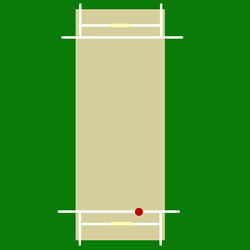| Part of a series on |
| Bowling techniques |
|---|

Left-arm orthodox spin or left-arm off spin, also known as slow left-arm orthodox spin bowling, is a type of spin bowling in cricket. [1] Bowlers using this technique bowl with their left-arm and a finger spin action. Their normal delivery spins from right to left (from the bowler's perspective) when it bounces on the pitch.
Left-arm orthodox spin bowlers generally attempt to drift the ball in the air into a right-handed batsman, and then turn it away from the batsman (towards off-stump) upon landing on the pitch. The drift and turn in the air are attacking techniques. The normal delivery of a left-arm orthodox spin bowler is the left-arm orthodox spinner. [2]
The major variations of a left-arm orthodox spin bowler are the topspinner (which turns less and bounces higher in the cricket pitch), the arm ball (which does not turn at all and drifts into a right-handed batsman in the direction of the bowler's arm movement; also called a 'floater') and the left-arm spinner's version of a doosra (which turns the other way).